[Updated on 1 January 2024] Imagine a sport that is responsible for just as many breakups as it is for business deals. Think about a game that burns more calories in an hour than going for a run. Envision a game that is accessible to anyone who has a court near them. What game could be this perfect? Squash!
For anyone who has never played the game, Squash may look like one of the strangest sports ever invented. For those of us who play and love the game, we know how addicting the game is. This article will tell you everything you want to know about squash as well as a few things you didn’t even know you wanted to know.
Contents
History of Squash
All sports have interesting histories, but Squash has to be toward the top when it comes to sports with unique beginnings. Squash wasn’t created as much as it evolved from other sports over time. One may believe that Squash is an evolution of tennis, which is true, but there was a stop in between in its journey.
In the 1700s men in London’s prisons played a game called Rackets that was the ancestor to Squash. Somehow the game found its way to the London’s boy’s Harrow school in the early 1800s and expanded to other schools from there. When the boys realized that a punctured ball “squashed” against the wall creating more varied ball movement, a new sport was born.
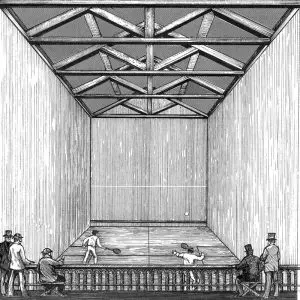
It wasn’t just the ball that evolved; the first Squash courts at the Harrow School also went through a lot of changes. The original courts were dangerous because they were built in unsafe conditions often close to protruding infrastructure like ledges and chimneys. These confined spaces also led to modifications of the rackets to make them smaller so they could move more freely in tight spots. It wasn’t until 1864 that the Harrow School built outdoor courts that were safer and larger.
Before the 20th Century Squash had already come to America by way of St. Paul’s School in Concord, NH. A teacher named James Conover had seen the game being played in Montreal, Canada and thought it would be an excellent game for the boys at his school. Conover wrote in the school magazine, “It is the universal experience, that for health and for the highest perfection in the game, the average boy or man should play but one rubber a day.” From there, courts were built at Harvard and the game spread through private men’s clubs in the upper east coast.
In the early 20th century Squash exploded around the world with courts popping up on almost every continent. Squash courts even found their way onto boats like the Titanic and the battlecruiser HMS Renown. Around this time governing bodies started to form, and Squash championships were organized.
World War II took a toll on the sport with many countries (and players) focusing their efforts on the war. The only countries to continue their national championships during the war were Sweden and Ireland. Many of the courts were destroyed in the war, which set back the popularity of the game when the men returned home.
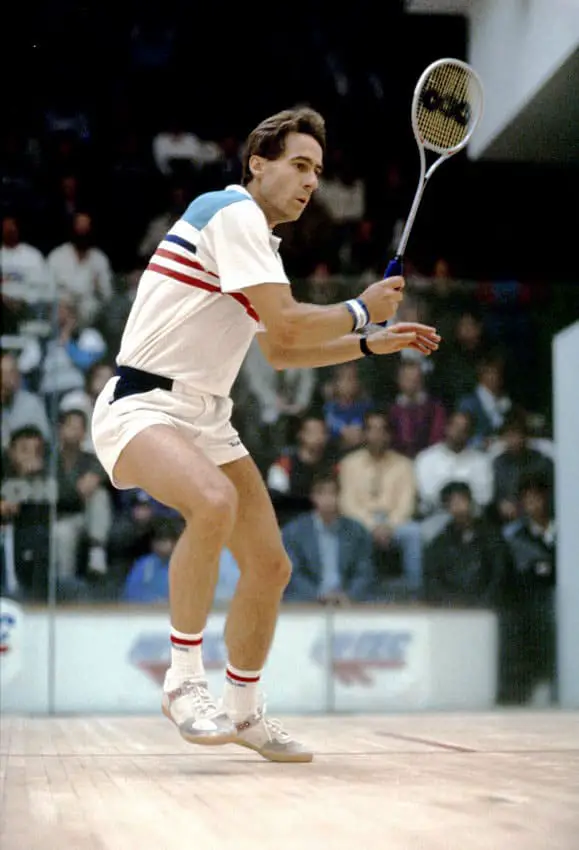
By the late fifties, the sport was back in full swing and even televised for the first time. Through the next four decades, the game continued to grow, and changes were made to the rules and the court as the sport continued to evolve. The 2000s have been a pretty even keel time for the sport as well with a few exceptions. Squash, which should rightfully be an Olympic sport, was turned down by the Olympics committee for the third time in 2015 and in 2017 it was announced that Men and Women would receive the same prize money in Professional Squash Association tournaments, something that many mainstream sports have yet to do.
Where to Play Squash
There are thousands of Squash courts around the world, but they aren’t on every corner. Luckily there is this handy tool to help you find a court near you. All you need to do is type in a little information like your city and state, and it will bring up both locations near you and sanctioned activities at each location. Most venues also have a phone number listed so you can call for more information.
Squash Overview
The Goal of the Game
Players use the walls of the court to bounce the ball at different angles and speeds in the attempt to make their opponents miss. The goal is to make the ball unplayable by the opponent. With a confined space and unpredictable ball, this isn’t always the easiest task.
Scoring is probably the most important factor when we talk about the game. Squash sets are played to 11 with a winning margin of 2, so if the score is 11 – 10 the player with 11 would still need another point to win. One point is awarded when a player fails to return the ball after a single bounce. A match consists of five sets, and the winner of the match is the player that takes three of five sets.
Squash is played in singles or doubles. Singles is a one on one match where the players can move anywhere on the court. Though Squash courts are relatively small, even on a doubles court, it is possible to fit four people on the court with one player from each team playing the forehand and the other playing the backhand.

Squash Terms to Know
Before you get started, there are a few terms that will continually pop up when reading about and playing the sport of Squash. Knowing these common terms will help you master your understanding of the game.
- Point (winner) = the player who hit the unreturnable ball to their opponent
- Game (winner) = the first player to score 11 points
- Match (winner) = the first player to win the required number of games (typically 5) wins the match
- Let = A let is called when a player accidentally gets in their opponent’s way and is unable to get out of the way.
- Stroke = a stroke is called when a player hits the ball back to themselves while their opponent is getting ready to hit the ball. A point is given to the player trying to return the ball.
Squash Court
How to Find the Right Squash Court for You
If you are just getting into the sport or if you find yourself in a new area, the best thing you can do is turn on your location services and search for “squash courts near me.” Usually, you will find several courts in your general vicinity. There are several venues that house squash courts, and not all of them are available to the public. Once you find the ones that are closest to you, you will want to break them down to see if they are right for you. Below are a few examples of different venues and what to keep in mind when weighing the right court for you.

Private Squash Clubs
Private squash clubs will have membership dues involved, but that is not necessarily bad. If you are serious about the sport, this is the best place to be because people who aren’t as serious about it will probably not pay a membership fee. There is also the networking aspect, memberships to private clubs are not just handed out at random and meeting and networking with other professionals is a huge perk to joining one of these clubs.
Country Club
Country clubs have many of the same benefits of private squash clubs. The biggest differences are that they will probably not have as many courts as a dedicated squash club and you will find more hobbyists than serious players. Like squash clubs, country clubs are an excellent place to network while enjoying the game you love.
Fitness Clubs
A lot of the bigger fitness clubs and community centers across the country have a court or two. Usually, you need to be a member of the club to use their facilities, but you may be able to pay for a day pass to use the courts. Again, this is a less expensive option, but you will have trouble finding a serious opponent if you can find one at all.
Colleges
Colleges across the country have squash courts for students; a lot of them even have squash teams. Some colleges may allow the general public to use their facilities, but there is most likely a fee involved. If you are a student at a school, this is the first place to look because you will likely have free access and find some healthy competition.
Community Living Areas
One place that one may not think of to find a squash court is at a community living area like an apartment or townhome complex. If you are moving to a new town and are already looking for housing, it wouldn’t be a bad idea to add a squash court to your list of desired amenities. It doesn’t hurt to ask around either; one of your friends may have a court available at their complex.
Squash Court Dimensions
Squash courts vary in size depending on whether you are playing singles or doubles. Apart from that distinction, all courts should have the same dimensions. If you take your game seriously, especially if you are training for competition play, you want to make sure that the court you practice on matches the official dimensions.
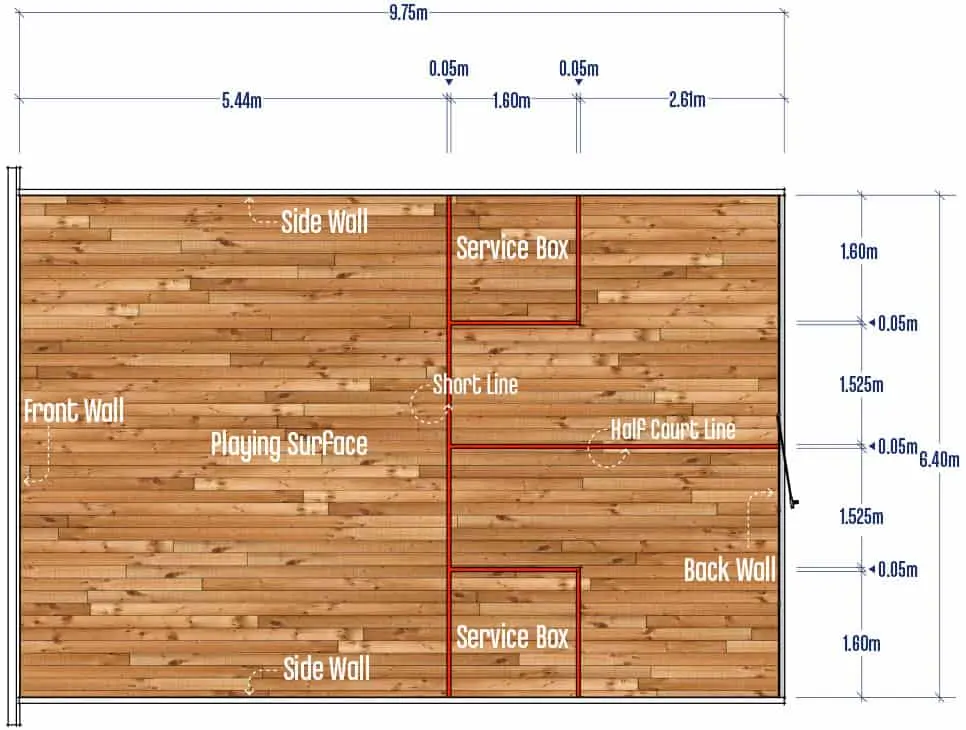
Singles Court
An international squash singles court measures 21 feet wide by 32 feet long. Though the minimum ceiling height needed is 18.5 feet, 20+ feet is preferable. There are no exact specifications for the lighting layout or wall material.
Hardball Doubles Court
With double the amount of players, the doubles court needs to be significantly bigger than a singles court. The doubles court should measure 25 feet wide by 45 feet long and have a ceiling height of at least 24 feet but preferably 26. Maple and plaster are preferred wall materials with hardball, but there are exact specifications.
How to Build Your Own Squash Court
If you have space and love the game, you can build a squash court of your very own. One may think that all you need to build a squash court is a few walls and a floor, but there is much more to consider when building your court. Most importantly, you want your court to be safe for players and can withstand the constant impact of the ball.
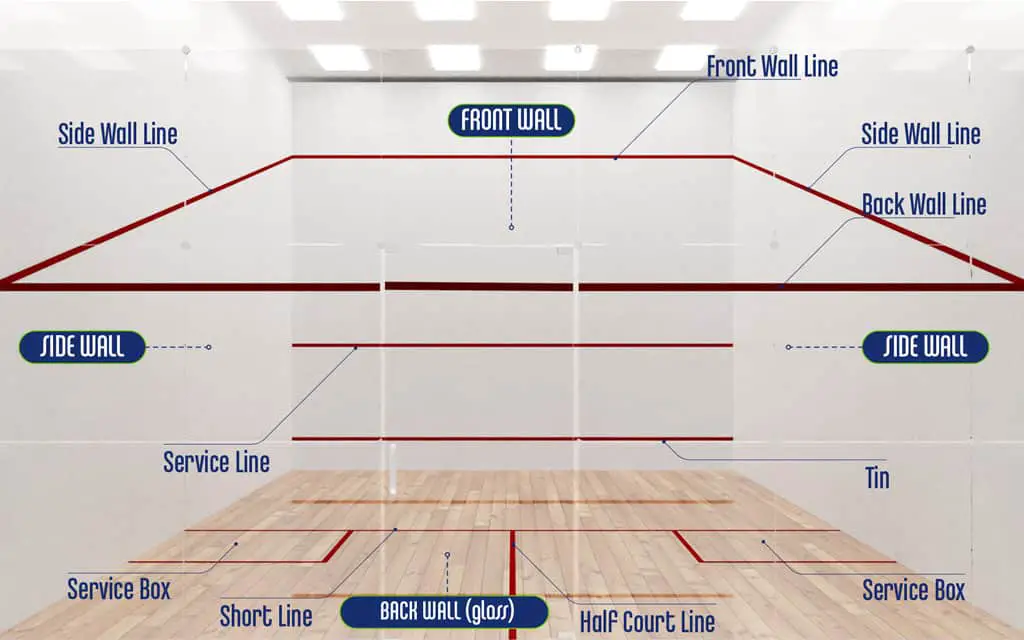
Playing Surface
There are many types of materials that can make up the walls of a squash court, including wood, concrete, plaster, and glass. Each wall should be a solid material throughout, but adjacent walls don’t need to be the same materials. Court walls can be different colors, but they are traditionally white.
Material isn’t the only concern with the playing surface; construction can also make or break your walls. Any irregularity in the walls, like seams or cracks, will cause a bad bounce, which is annoying and will cost you a point. The best way to get around these issues is to avoid plaster, which tends to crack and use solid pieces of material for the whole wall instead of joining together several smaller pieces.
Floors
Traditional floors are made of hardwood for an elegant finish and nice bounce, but hardwood is not great for the joints. Newer courts are being built with engineered floors that have the same elegant look and ball rebound as traditional hardwood floors but have a little more give which is easier on the joints.
The most important thing to think about when building your court is the rebound that your ball will have. If you are not sure what kind of material you like the most, it is a great idea to try as many as you can to see which rebound feels the best to you. You can do the same thing with wood versus manufactured flooring to test if the bounce in the latter feels the same to you. It’s your court, so everything must feel perfect for your personal style of play.
Gear
Squash may seem like a simple sport from the outside, but like many sports, there are so many minutiae that can affect your game. This section is meant to give you a better understanding of the equipment that you will need to play the game and the features you should be looking for in your equipment.
Racquets
Racquets are obviously the most important part of the game. There is no perfect racquet for everyone because everyone has their personal preferences, but there are a few things to consider when choosing the racquet that is perfect for you.
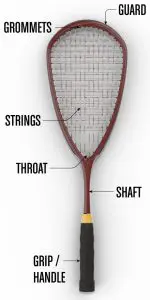
- Throat – A throat is the triangle part of the squash racket where the strings meet the handle. In an open throat design, the strings are rounded off, and there is an empty area between the strings and the handle. In a closed throat design, the strings go all the way down to the handle. Open throat designs offer more control, while closed throat designs usually generate more power.
- Balance – There are three different ways that a racquet can be balanced. With the head heavier than the handle, you will find that there is less maneuverability, but you will have more power with less effort. If the handle is heavier than the head, the squash racket will feel lighter and easier to swing. Much like most things in life, a balance of the two is what most players prefer because you get great maneuverability but still generate power.
- Grip Shape – The shape of the grip may seem trivial, but it can make a huge difference for some players. A rounded handle is comparable to the handle of a baseball bat while a rectangular handle is more like a tennis racquet. The shape of the handle doesn’t have any standard effect on the swing; it all comes down to what is more comfortable in your hands.
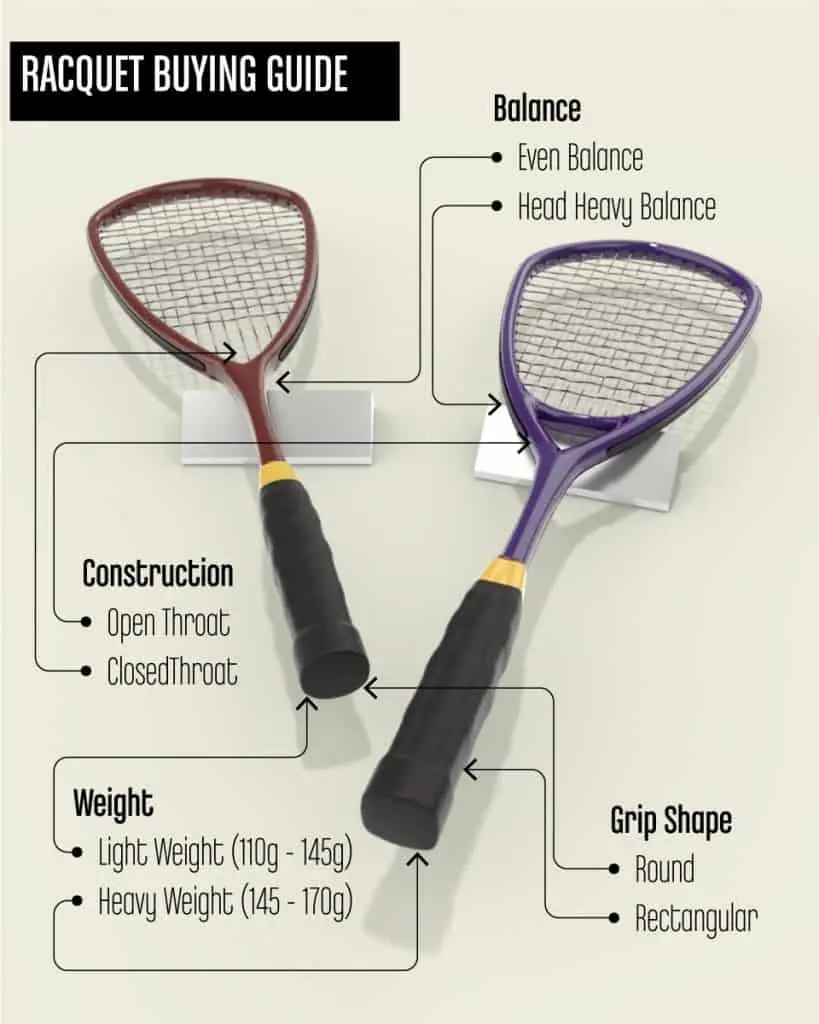
Want to use this infographic on YOUR site?
Shoes
You will be able to get away with tennis shoes when you first start, but after a while, you will find that you want a shoe that is more specific to your sport. When it’s time to buy some dedicated squash shoes, there are specific features to keep in mind.
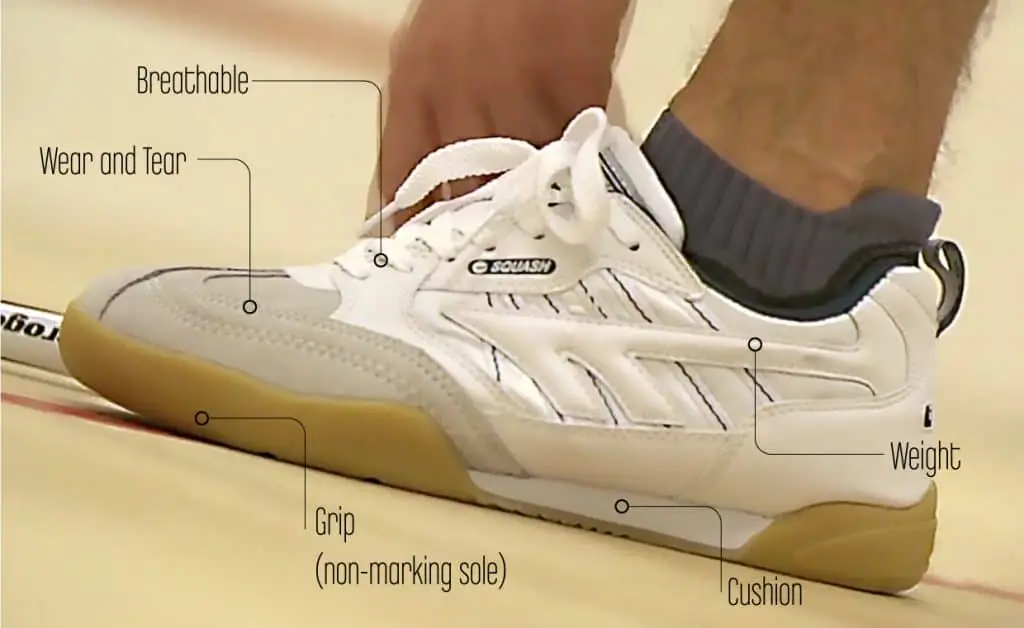
- Weight – Even a few ounces can make a difference after a while when moving back and forth on the court. A heavier shoe will offer more joint support, but it will also slow you down. Try to find a balance between the two that will leave you protected but allow you to be agile.
- Breathable – There is more than one reason to find a breathable shoe. From a hygiene perspective, these shoes will start to smell pretty strong after a few outings if they don’t breathe well, but it’s more about safety. A shoe that doesn’t breathe gets sweat, and your feet will start to slide around in your shoe, which creates dangerous conditions when you are sprinting back and forth on the court.
- Cushion – Cushion is important to keep for feet comfortable in the game, but it has a more important function. The hardwood of traditional squash courts has no give, so it has a high impact on joints. Having a good cushion in your shoes softens that impact from the floor and saves your joints.
- Grip – There is so much stopping and starting in this game that grip is a huge factor when choosing the right squash shoe. You want something that will let you stop on a dime and change direction in an instant.
- Wear and Tear – Unfortunately, the only way you can figure this one out is through reading reviews and personal experience. The movement of the game puts a lot of stress on shoes, and a poor quality shoe will fall apart at the seams. For the most part, you get what you pay for when it comes to durability.
Balls
There are six different kinds of squash balls that you may come across, ranging from a fast beginner ball to the slowest standard competition ball. These balls are distinguished by colored dots on the ball as follows:
| Blue Dot | Fast Ball (Best for Beginners) |
| Red Dot | Medium Ball |
| Green Dot | Slow Ball |
| White Dot | Slow Ball |
| Yellow Dot | Super Slow Ball |
| Double Yellow Dot | Extra Super Slow Ball (Competition Standard) |
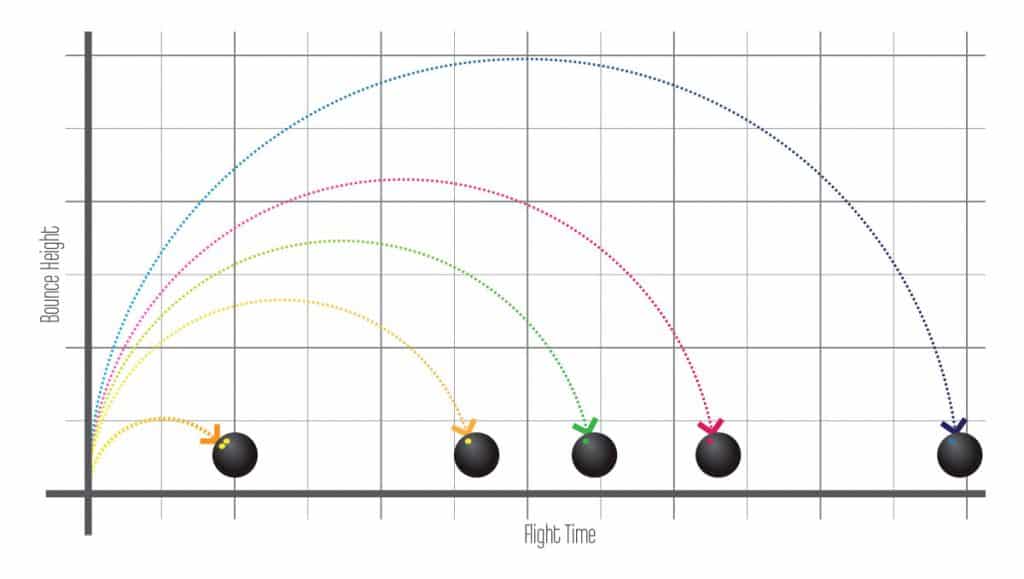
Goggles
Squash is a fast-moving sport in a confined space, so accidents are bound to happen. With balls, racquets, and body parts flying in every direction you want to make sure that your eyes are protected from injury. It also gives you a slight competitive advantage knowing that you never need to flinch.
- Regular Goggles – If you don’t have corrective lenses you can use regular, ISA approved goggles. Great goggles are scratch resistance to prevent deep scratches from hampering your view; they are also shatter-resistant to prevent damage to the eye in the rare case that your goggles break. These goggles come in two styles, one that is worn like a regular pair of glasses, or the other that has a strap and is worn more like a swimming goggle.
- Over the Glasses Goggles – All of the features of the regular goggles are still necessary for goggles that fit over your glasses, but they also need to fit over your corrective lenses comfortably. Since they need to fit over your regular glasses, these goggles are often larger, and some players find them cumbersome. If you are a frequent player, it may make sense for you to buy prescription squash goggles that meet all of your needs.
Bags
For a sport that takes place in such an enclosed space, there is a lot of equipment involved. To simplify your life and keep all of that stuff together, you want a reliable bag. You may be surprised to find that there are more than a couple of different bag styles from which to choose.
- Shoulder Bag – A single or double strapped bag that you wear on your shoulder and has room for all your gear.
- Backpack – Smaller than a shoulder bag, usually they are designed with the handle of your racquet sticking out of the bag.
- Duffle Bag – This is a traditional gym bag that holds all of your gear comfortable, but is not as stylish.
- Travel Bag – These bags are specifically designed for you to travel with your equipment on airplanes safely.
Grip
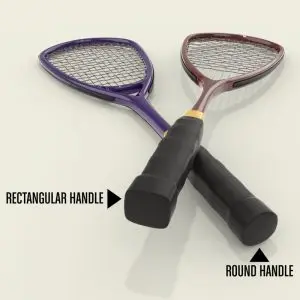
Squash is an active sport, and you are guaranteed to work up a sweat. The last thing you want is for your racquet to go flying out of your hand in the middle of play. Your squash racket most likely comes with the grip around the handle already, but it will eventually wear and fall off. Sometimes you may find that the grip on your handle is simply not sufficient enough. No matter what the reason you always want to keep extra grip tape on hand to fix up your racquet as needed.
Clothing and Accessories
Squash is a dynamic sport, so you need clothes that are dynamic too. There are certain elements of clothing that you will want to look for when you are purchasing your squash outfit.
- Breathable – Squash requires a lot of exertion, which means you will get hot and you don’t want that heat being trapped under your clothes. Be sure that your clothes, especially your shirt breathes well so that excess heat can leave your body.
- Sweat Absorbent – Sweat absorbency is important for accessories. Head and wrist bands are an excellent tool to have when you are playing, and they add a bit of style as well. Make sure that your bands keep the sweat out of your eyes and aren’t just for show.
- Durable – Though you shouldn’t be as hard on your clothes as you are on your shoes, the constant direction change of the game tends to wear on your seams. You want clothing that is strong and won’t tear with the constant movement.
- Light and Comfortable – With all of the moving, you don’t want heavy, cumbersome clothing to be weighing you down and you don’t want to be focusing on clothes that are too tight or itchy while you’re in the middle of a game.
How to Play Squash
Player Progression
Like any skilled sport, squash takes some time to learn and even more, time to master. No one should expect to be a pro the first time they pick up a racquet. There is a progression of skills that players collect as they make their way up the ladder.
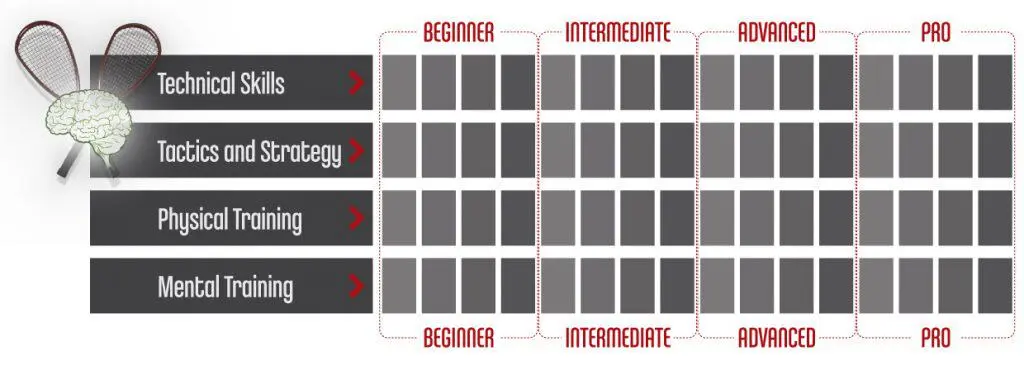
- Technical Skills – These beginner skills like footwork, stroke, and special and ball awareness are all the first steps needed. This first step takes a lot of practice and even more patience.
- Tactics and Strategy – Once a player has the basics down, they can then start moving into planning. Learning to set up shots, position opponents, and make an overall strategy to win are all parts of this next level of play.
- Physical Training – When a player has all of the technical aspects down, one of the last ways to improve their game is to improve their body. With physical training, a player can move faster, hit harder, and have more stamina.
- Mental Training – The last aspect of becoming an expert squash player is building mental resilience. It’s not easy, and it takes experience, but knowing how to keep a clear mind and stay disciplined in the face of adversity is what separates the best from the rest.
Playing Singles Squash
Singles squash is a great way to stay in shape and meet new people. You must know how the game is played before engaging other players.
Serving
A perfect serve takes a lot of practice, but there are a few key elements that every legal serve should have. The server should have at least one foot touching the floor inside of the service box. The ball must hit the back wall before hitting any other walls then bounce behind the short line on the opposite side of the court as the server. The ball does not need to bounce behind the short line if the opponent hits it before it bounces.
The point of the serve is to start the ball in play, but it is also to make it hard to return. Every player has a different serving style, and there are several strategies and forms that are used to create a difficult return. The best thing to do is look up different serving strategies and try them out to see which one(s) best fit your playing style.
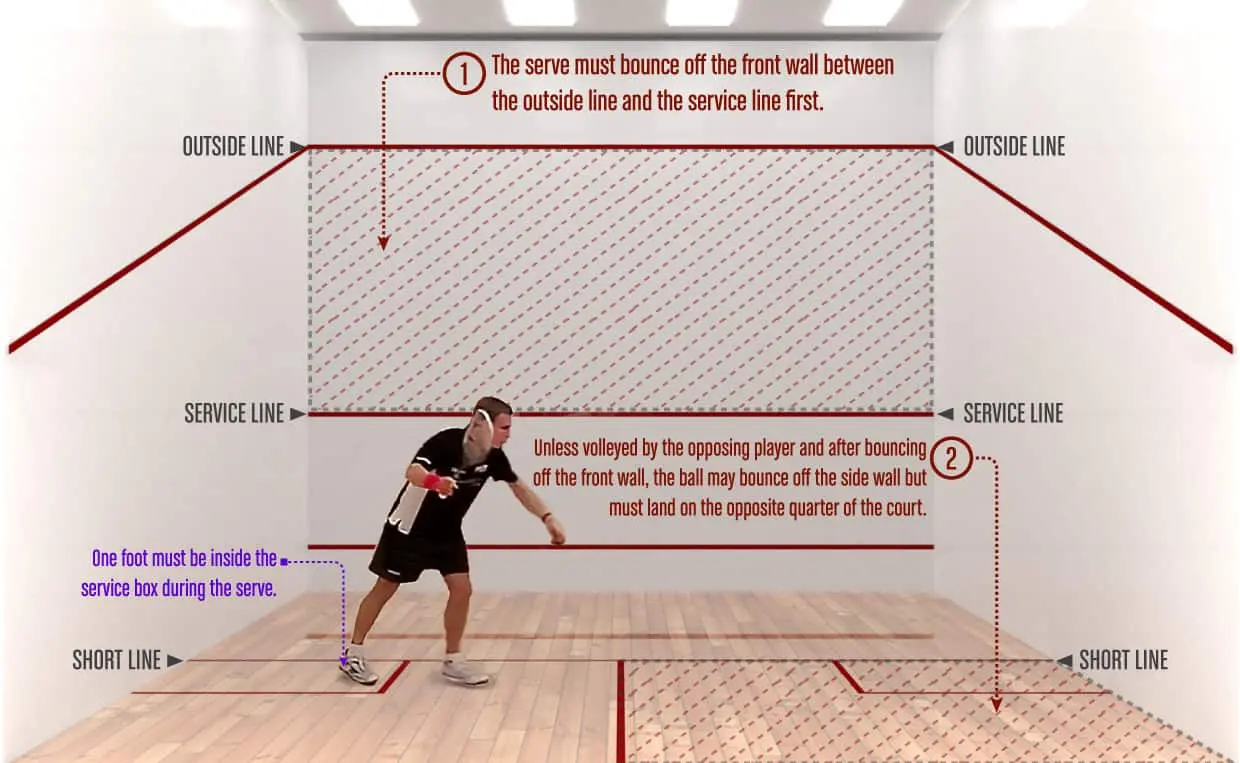
Rally
Once the ball is in play, the players will rally the ball back and forth by hitting it off one or more walls then hitting the ball after one bounce or less back to the other player. Each player tries to set up a play where they can attack with a strike that the other player can’t return.
Scoring
Squash is usually played in a best of five format with each match being played to 11 points. The game must be won by 2 points, so if the score is tied at 10, it is the first person to pull ahead by 2 that wins. A point is scored when the opposing player is unable to return the ball in one or fewer bounces. Players can also win a point if the opposing player interferes with their shot, hits the ball out of bounds, or the serve does not follow the rules.
Singles Squash Strategies
Dominating the T
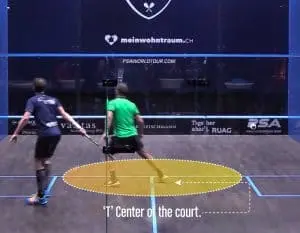
The T is the name for the point where the half-court line meets the short line on the floor. This is one of the most popular strategies in the game because it puts you in the center of the court to return your opponent’s hit without needing to move too far in any direction.
The best way to dominate the T is to volley a lot and use low drives. As soon as you hit the ball, you should return to the T. When you take your first shot, whether you are serving or receiving, it is important to make your opponent run to retrieve the ball so you can position yourself in the T.
Wear Your Opponent Out
Another widely used strategy is to make your opponent work for their shots. The goal is to make your opponent move as much as possible, which requires a combination of different shot styles. For instance, you may want to start with a lob that makes your opponent back up to hit the ball then return their return with a low drive that forces them to run forward. After a while, your opponent will begin to tire, and tired opponents make mistakes.
Change Direction
In the game of Squash, unpredictability is key. The whole point of the game is to make sure your opponent doesn’t hit their next shot, so the best strategy you can have is to confuse them as to where the ball is going. This can be done in several ways, but the best way is to use a few drop shots, then a boast shot, followed by a cross-court shot.
Playing Doubles Squash
While doubles squash is the same game, it has some distinctively different rules. Having two players on each teach changes the dynamic of the game and requires much less movement than regular squash, so the strategies are different.
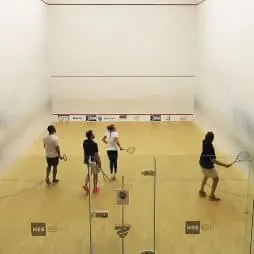
Serving
Since there is not a lot of movement in doubles, the serve is extra important in setting the tone of the match. The rules of service are similar to those of singles; the server must have a foot in the server box, and the ball must hit the back wall before hitting another surface. There are several different serves that you should vary to keep your opponents on their toes, but in doubles, a serve is much more about putting the ball in play than it is about scoring the first point.
Rally
When rallying in singles it’s all about moving your opponent around as much as possible, but that isn’t as much of an option in doubles. Players still take turns volleying the ball back and forth, but it is more about skill shots and getting the other team off of their positions. Though the court is bigger, cross-court shots are more common in doubles because a well-placed shot will move the opponent off their spot.
Scoring
A score occurs when the receiving team is unable to return the ball in one bounce off the floor. In doubles, games are usually played in best of three or five matches. Games are played to 15 points but must be won by two, so if the score is 14-14, the score will have to be 16-14 for a team to win. Players can also win a point if the opposing player interferes with their shot, hits the ball out of bounds, or the serve does not follow the rules.
Strategies
The strategy is a little different in doubles matches, with two players on a team; it is not so much about dominating the T or moving your opponent across the court. Instead, it is more about skilled shots and getting your opponent out of position so your teammate can attack.
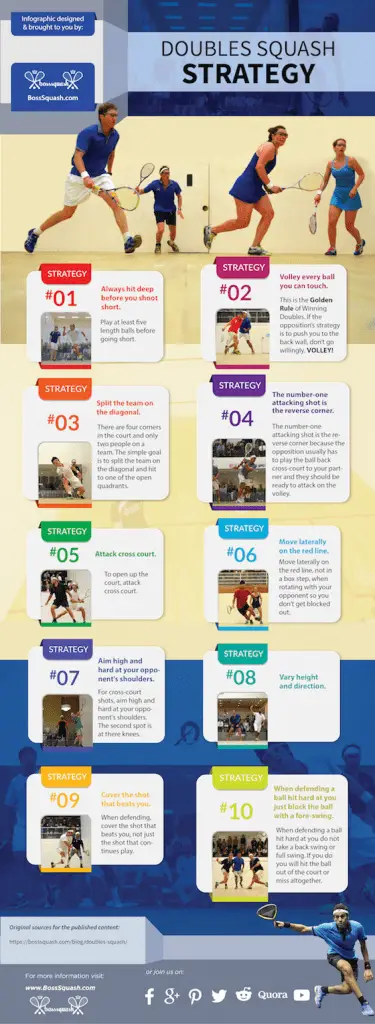
Split Them Up
With two players on a team, it can be difficult to find a hard to reach spot. The further apart diagonally that you split up the opposing team, the more space in the middle you have to attack.
Vary Your Shots
The best way to win a game is to keep the opposing team out of rhythm; to do this, you have to have unpredictable shots. Hit a deep ball then follow it with a short drive and always change the height, speed, and the direction of your shots.
Control the Court
Controlling the court is the most important aspect of doubles, and your opponents will be trying to do the same thing. Never leave your spot if you don’t have to which means volleying every shot you can reach even if you can’t set up an attacking shot. If you or your opponent is forced out of their spot, it is the other player’s job to hit a slow lob and give their teammate time to get back in position.
How to Referee a Match
Whether you have plans to referee a match or not, this is an important aspect of the game you should know. Not only will it help you to understand the rules of the game, but it will give you some empathy toward the referee of your game.
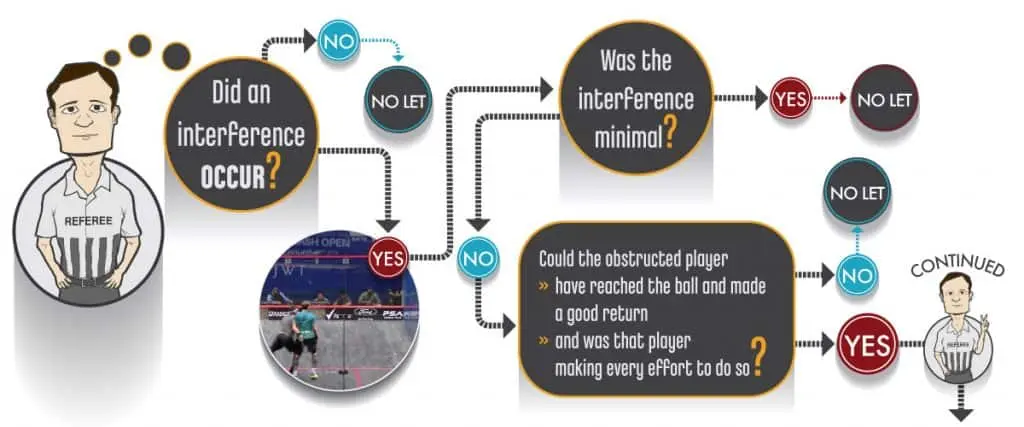
- The referee controls the schedule and can shorten the warm-up period to as little as five minutes if they choose. They can also cut a longer warm-up period short, so the game starts on time.
- The referee’s decision is final with a caveat. If available, you can have two judges to review the referee’s call. If both judges disagree with the referee, the call is overturned but if it is a split decision the call stands.
- Squash is a game of decorum; if a player uses language or actions unbecoming of the game of squash, the referee may remove a point from the offending team for each offense.
Players and referees should know these important rules of the game:
Right to Play the Ball: Immediately after hitting the ball, a player must move out of the opponent’s way and give them a clear view of the ball. Players can’t do anything to hinder their opponents playing the ball including physical, visual, or audible distractions. If any of these occurs, the receiving player is given a point called a “let point.”
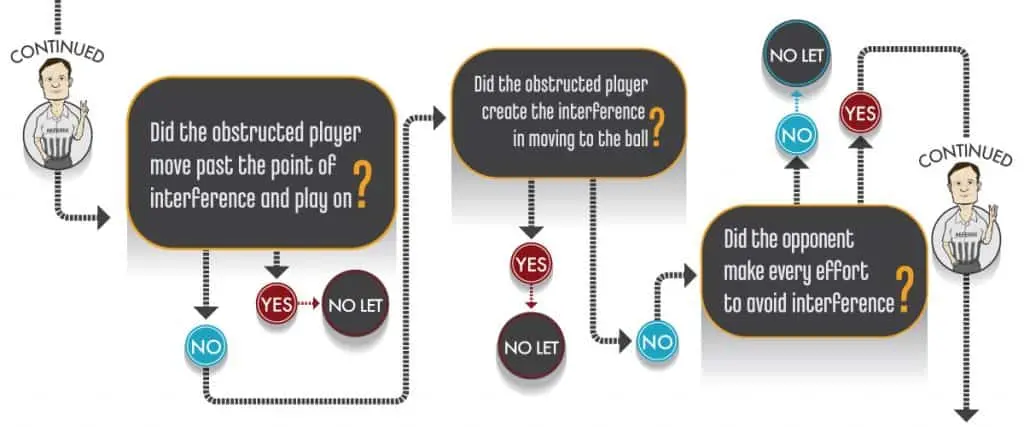
Let: A let is the replay of a point for several reasons. It is often due to the faults listed under Right to Play, but there are a few more reasons for a let. Lets can also happen for the following reasons:
- A player stops play to prevent harm to another player.
- Any piece of equipment breaks during play.
- When the receiver touches another player when striking.
- A player can request a let at any time at which point the referee allows the let, gives a let point, or denies a let.
- A referee may call a let if there is any interference with play beyond the control of a player or if they believe a player could sustain an injury.
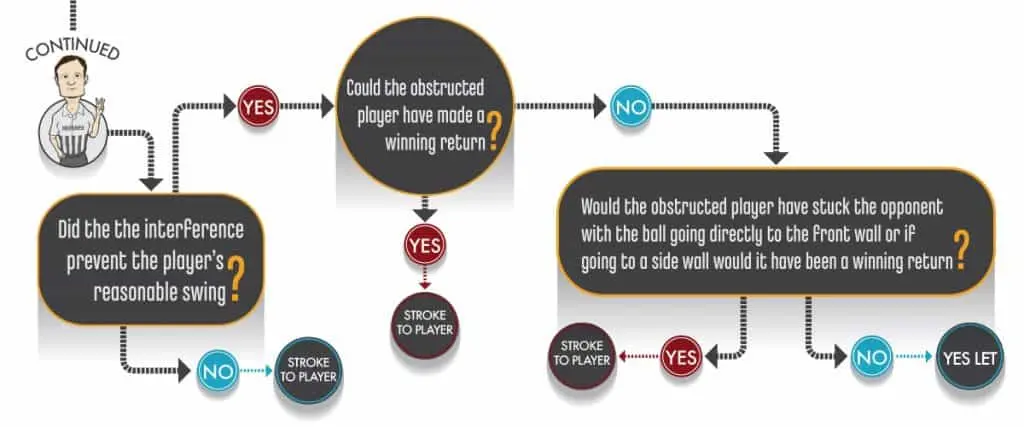
Squash Training and Drills
Just like any sport, the more you practice, the better you get. Experience doesn’t come solely from playing against other players; there are several drills you can perform on your own to improve your stroke and footwork.
Drills for Beginners
Serve Drills
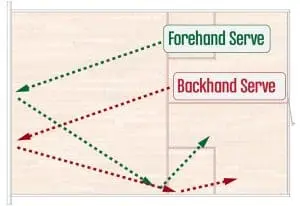
Serving is a great place to start when practicing drills. Practice 10 lob serves from different serving boxes trying to hit the wall high and land it cross-court near the wall. Next move to 10 smash serves from different serving boxes. These hits should be low and hard with the intent of landing in the opposite service box.
Lob Drills
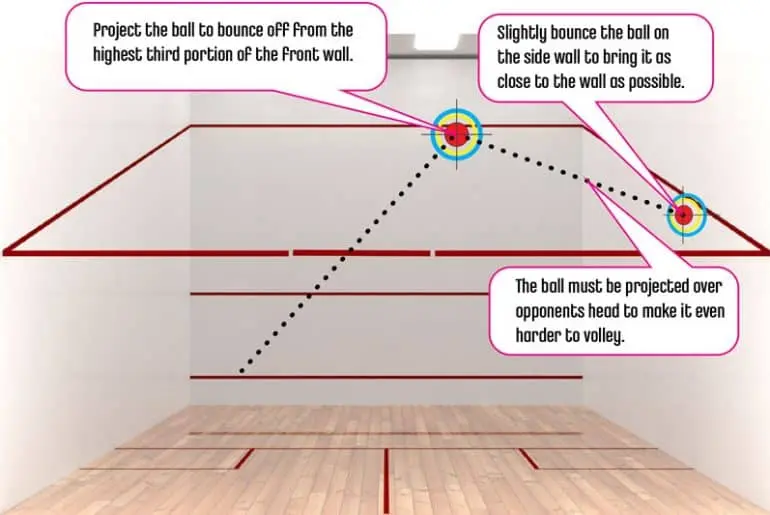
Set the ball in motion with a soft hit then return the ball with a high arc aiming the ball toward the right side rear wall. Continue to practice this movement alternating which side of the court the ball lands.
Straight Drive Drills
Stand close to the back wall of the court and hit the ball toward the wall directly in front of you. Left-handed players will start on the left side, and right-handed players will start on the right side. Hit the ball, so it returns behind the service box and as close to the wall as possible. Start in the entire back corner then slowly close in until you only need a small area near the sidewall.
Solo Squash Drills
Straight Drive
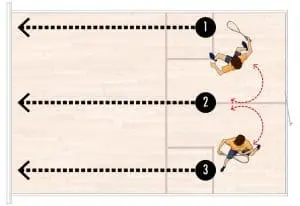
Practicing your straight drive is a great way to build your strength and accuracy. Don’t be afraid to bring a target with you to practice landing effective drives. Concentrate on form and keep your head straight and follow the ball with each strike.
Short Hit
Stand on the short line and keep striking the ball, so it hits below the service line. This is another drill that helps with accuracy and builds strength and stamina in the forearm. Alternate between striking with the left and right foot to get a feel for weight transfer when switching positions on the court.
Volley Drop
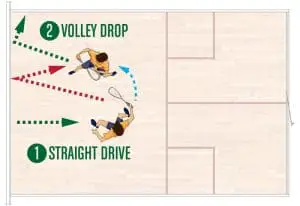
Hit a few volley drives, then switch to a volley drop and try to recover it. Repeat this pattern to train your recovery speed as well as perfect your volley drop for strategy.
Corner and Hard Low
This is one of the more difficult drills you will perform, and it is great to strength and stamina building. Stand at the front line and aim toward the right corner of the front wall. Try to hit balls in the same spot for several minutes continuously.
Figure 8
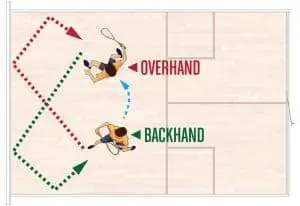
This is a fun drill that is designed to get you comfortable switching between front and backhand. Stand a few feet away from the wall and volley the ball off the wall switching between front and backhand for each hit. Your racquet should be drawing an eight in the air as you switch.
Squash Drills for 2
Striking to Length with a Backhand
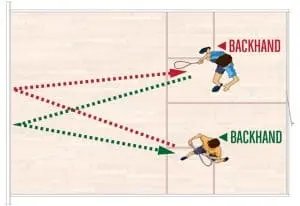
Use the backcourt to hit the ball across the court. The player on the left-hand side of the court should hit the ball hard and low while the person on the right-hand side should return the ball soft and high. Players should continuously switch sides throughout the drill.
Service Practice
The nice thing about having a practice partner is having someone to return the ball to you. Practice your serve while your partner returns it, and make sure to give them a chance to practice their serve as well. Switch sides to get a feel for serving from both sides.
Long Shots
This is a fun training drill that you can do during a game. All you have to do is play each shot, so it lands past the service line.
Service Box Target
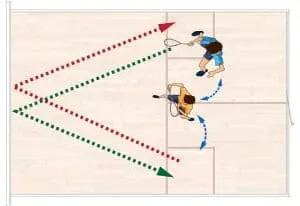
This is another training drill that can be played in-game to improve your accuracy. Players can only score points if they land the ball in the other player’s service box. To make it more challenging, volleys can’t be used. Switch sides after every set to practice from both sides of the court.
Squash Ghosting Patterns
Ghosting may sound a bit ominous, but it only means going through the motions without using a ball. Going through the motions without a ball is popular in many sports, and it is a great way to work on technique and muscle memory. Since ghosting patterns are a reflection of the real thing, there are hundreds of combinations, so there is no set pattern for you to follow. To get started, there are a few guidelines that will help you to be organized.
Structure
You could spend all day swinging your racquet around with no purpose if you don’t have structure. You can measure your ghosting by a set time frame like 3-minute drills, a set number of shots, or a set number of rallies.
Energy
Ghosting is supposed to mimic the real game, so you need to bring the same amount of energy to this drill. Your patterns should include big movements that require you to move cross-court just like you would in a real game.
Patterns
You can easily do this yourself, but it helps if you have a partner to call out shots for you. If not, use some imagination and go through the motions from serving, to volleying, and even striking and returning your invisible ball.
Types of Squash Shots
There are several different types of shots that you will need to master to take your squash game to the next level. Not all of these shots are easy, and a lot of them take practice and care. In this section, you will find not only the definition of each shot but also a few pointers to improve each technique.
Forehand
A forehand hit is defined as a hit in which the palm is facing in the same direction as the ball.
The forehand shot is the most popular shot in the game, probably because it is such a natural movement. Though the movement is natural, you can still run into problems if you don’t have the proper grip.
One common mistake is holding the handle too hard. You don’t want the racquet to fly out of your hand but holding the handle too hard will cause blisters and makes it harder to adapt to certain shots. In the heat of the moment you may find that you will grasp the handle harder due to the stress of the game; be conscious of this and remember to loosen your grip as soon as you get back to the T.
The other common mistake with the forehand is the way players grip the handle like a tennis racket. A proper squash grip has the bottom three fingers around the handle and the thumb and forefinger forming a “V” up the handle.
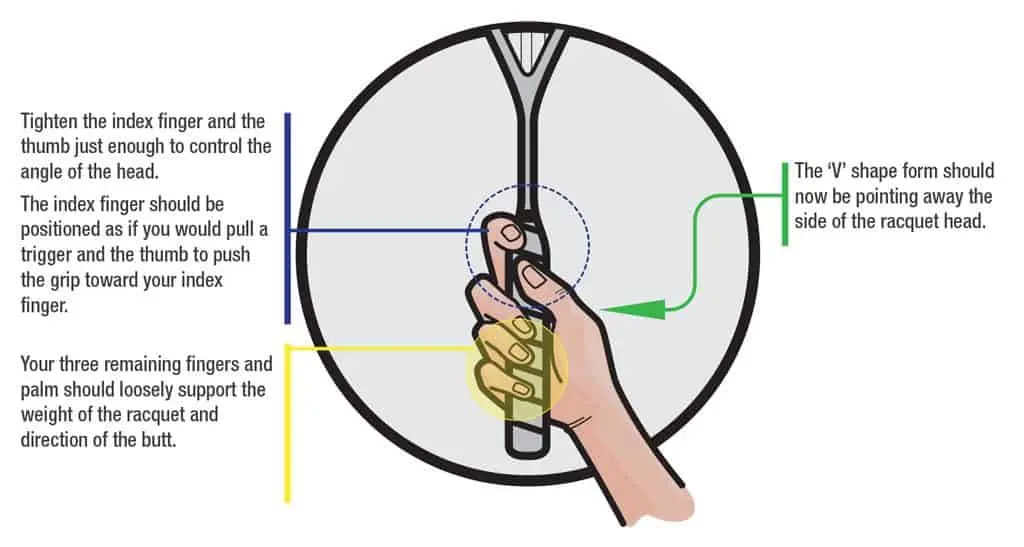
Backhand
A backhand is defined as a hit where your hand is facing away from the direction of the ball, and your arm is across your body.
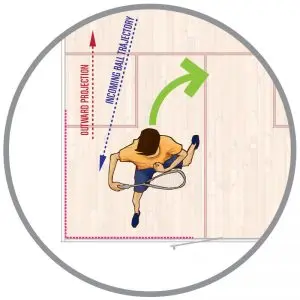
Some people go out of their way to avoid the backhand, but it is a lifesaving shot in Squash. A great backhand is what separates pros from amateurs. Since the backhand is a much less natural movement, there are plenty of things that can go wrong with this shot.
One of the biggest issues with the backhand is a player getting in their own way. A player may accidentally place their other arm in the way of their backhand and block their own shot. They may also stop their wrist halfway through the swing, which causes a loss of power in the stroke and may lead to injury.
The other big problems with the backhand shot are not keeping your eye on the ball, or keeping your eye on the ball for too long. You should watch the ball through your strike then get back into position instead of standing still and watching the ball.
Drive
A drive is the most basic hit in squash, and it is defined as a typical groundstroke.
A drive is comparable to a jab in boxing; it is not usually a shot that is meant to score. Instead, it is used to wear out an opponent or set up other shots.
Great technique for a forward drive includes your wrist locked and the racquet above your head, your chest facing toward the sidewall, and your weight on the same foot as your dominant hand.
Cross Court
The definition of this hit is in the name; it simply means a shot that is hit from one side of the court to the other.
This shot is used to wear your opponent out, get them off their spot, or buy you time to get back to your position.
Technique is the same as a drive, but your chest is facing toward the wall, and the ball should hit high on the front wall on the opposite side of the court.
Drop Shot
A drop shot is a shot hit softly that is designed to drop short, so an opponent has to rush forward to recover it.
Drop shots are used to move your opponent off their spot or to counter the opponent’s drop shot and let you get back to your spot.
When executing a drop shot, your racquet head should be up, and your wrist should be locked in place. Aim the ball toward the front wall corner follow through toward that target. Use power from your thumb and forefinger to push the ball toward the target versus hitting it.
Volley
A volley is hitting the ball before it takes a bounce.
Volleys are used to speed up the pace of the game and finish a rally after you get your opponent off of their spot.
Your racquet should be held high above your head and your wrist locked. If it is a forehand volley, your wrist can snap to add more power to the shot. Your follow-through should aim at the spot where you are placing the ball, just like the drop shot.
Lob
A lob is a ball that travels high in the air after bouncing off the front wall.
Lobs are a great way to buy extra time to get back to the T, and they are also a great tool to use against shorter opponents that will have to back up to return the lob.
Keep your wrist locked and plant your weight on the foot of your dominant hand. Get under the ball with the face of the racquet and flick your wrist upward following through towards the ceiling. The goal is to have the ball bounce high off the wall and fall in the backcourt.
Boast
A boast is somewhat of a reverse shot where the shot hits the side wall first before hitting the front wall.
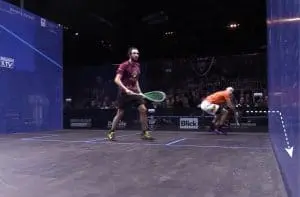
A boast is a tactical shot that tires your opponent out by making them run-up to the front corners and gets them off of their spot. It is also a great defensive move to play a ball out of the backcourt.
In a similar fashion to your drives, you want to have your racquet up and your wrist locked. The ball should be above the tin before you play it. Follow through towards the sidewall.
Reverse Boast
The reverse boast is a difficult shot that requires a cross-court shot to the opposite sidewall than the front wall.
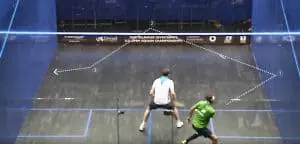
The goal of this shot is to deceive the opponent and hopefully get the point out of a risky move.
The reverse boast is performed in the same way as a regular boast. Keep in mind that if you are making this move from the backcourt, there is a good chance that you will hit your opponent with the ball.
Hitting the Nick
When reading about squash, you will often see the suggestion to aim toward “the nick.” This is the spot on the court where the wall and the floor meet. If a player can hit the nick, the ball often dies, making it unreturnable. It is an impressive shot and something to celebrate even if your opponent is the one who hit it.
Health Benefits of Squash
The court might be small, but the benefits are mighty when it comes to your Squash and your health. Squash isn’t just a fun game; it is great for your overall health, including muscle strength. It is safe to say that it is one of the complete workouts available and you get all the benefits while playing an enjoyable game.
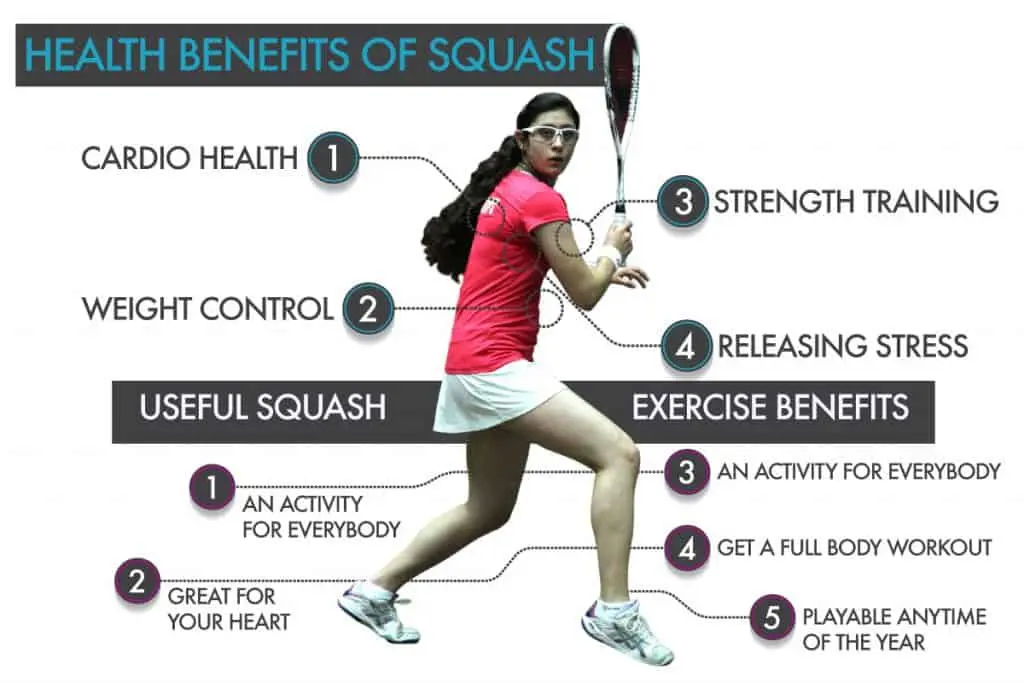
Cardio Health
The court may be small, but players are always moving from end to end. It is your opponent’s job to make you work for it. If running from end to end wasn’t enough, there is also a lot of jumping and lunging to get balls that are too high or low.
All of this work puts stress on the heart, forcing it to work harder and just like any muscle, the harder the heart works, the stronger it gets. A few hours a week of this game is enough to see serious cardiovascular benefits from improved stamina to the reduced risk of heart disease.
Mental Health
Improved mental health and stress relief are often overlooked benefits of any exercise, but squash especially. First of all, all exercise releases endorphins that release stress and improves your mood. Squash is an intense sport that requires a lot of thinking and concentration, so there is no room for your worries on the court. Even if it is a temporary relief squash will help you forget about whatever is bothering you that day.
While stress relief is a fantastic benefit and will lead to overall health, there is another brain benefit that is just as important. The fast pace of the game and the constant strategizing forces your brain to be working in high gear at all times. Working out your brain like this keeps you sharp and fights off the onset of diseases that affect your brain.
Strength Training
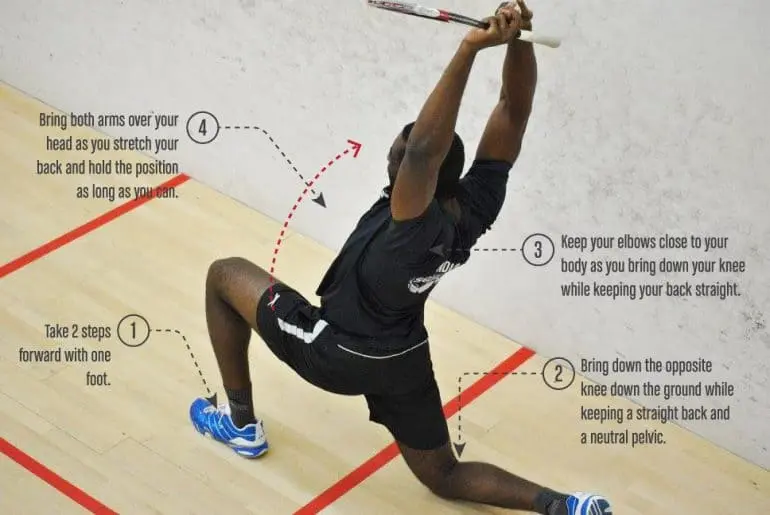
It might seem like squash is only about the cardiovascular work, but you get a great muscular workout from this sport. It is not like lifting weights, but between your body and the racquet, there is plenty of resistance to build muscle strength.
Repetitive movements of swinging the racquet, especially when engaging the arm muscles, are great for your entire upper body. The twisting and directional change involved in chasing the ball works the core more than one would realize and the constant jumping and lunging toward the ball gives your leg muscles a nice workout.
Weight Loss
You can’t be putting in that much work and not expect to lose a few pounds. Squash is a major calorie burner, so when you combine a few hours a week with a sensible diet, you will see the extra pounds start to melt off.
The number of calories someone burns during a workout is personal because it all depends on how hard one works and how much they weigh, but one can expect to burn between 400 and 500 calories during a half-hour game. They say that one pound of fat is 3,500 calories, so playing squash for half an hour a day can mean up to one pound a week lost. The best part is that the more weight you lose, the better your game will be.
Health Benefits for Everyone All Year
Anyone can play squash, which is great news because the game is so fun that you don’t even realize that you are getting such a great workout. Squash, being an indoor sport, has health benefits of its own. Since it is played indoors, it can be played year-round, so there is never a seasonal regression. More importantly, there are fewer environmental risks that can be harmful, like extreme temperatures and allergens that prevent people from exercising outdoors.
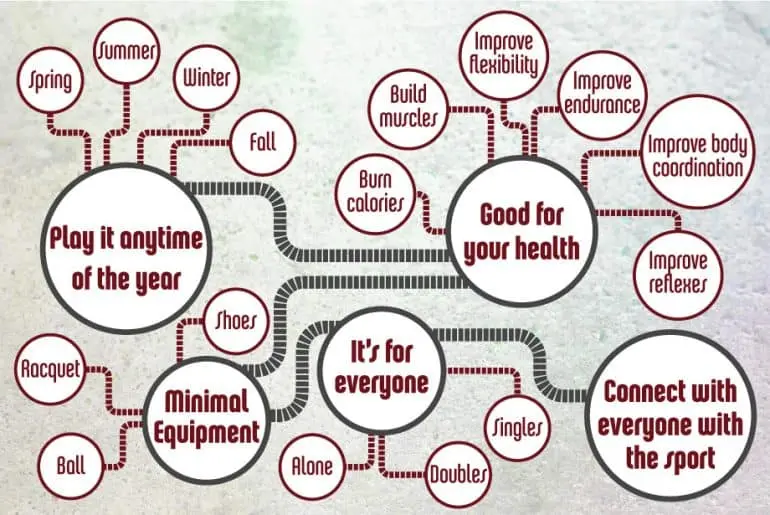
Squash Injuries and What to Avoid
Squash is an active sport, and with so much starting, stopping, and directional changes, the occasional injury can happen. You can’t stop them all, but there are several measures you can take to prevent chronic and acute injuries.
Common Squash Injuries
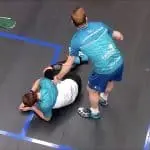
To understand how to prevent injuries, you must first understand common injuries and how they happen.
Impact Injuries
Squash is a non-contact sport, but that doesn’t mean that impact injuries don’t occasionally happen.
- Hitting the Wall – These injuries are incredibly common, but thankfully, they are rarely major. They often happen when a player is focusing too much on the ball and ends up running into the wall.
- Getting Hit With the Ball – Anyone this has happened to will tell you it is not fun. These balls move fast, and if they hit you, they sting, not to mention they will leave a welt behind with a bruise that lasts for days.
- Getting Hit with the Racquet – There is little space on a court, and it can be difficult to keep track of your opponent. It is not unheard of for someone to catch a racquet to the wrist which can do some damage, even if it doesn’t it hurts pretty badly.
All of these injuries can be mostly prevented with good special awareness, which is part mindfulness and part experience. If these happen to you, the best medicine is usually to ice the affected area and rest.
Muscle Injuries
With all the stopping, starting, and twisting muscle injury is a serious concern. Muscles can be strained or even torn, which is painful and can take a long time to recover. In the game of squash, hamstring injuries are common because of the stop and start motion of the game. Depending on the severity of the injury, it can take anything from some ice and rest to months of rehab to recover from an injury like this.
Joint Injuries
Joint injuries are commonplace in this sport for a few reasons, including repetitive use injuries as well as acute injuries brought on by sprain or strain. One of the most common joint injuries resulting from constant squash play is tennis elbow where the tendons in your elbow become inflamed from repetitive use.
Another issue that may rear its head after years of competitive play is arthritis, especially in the knee thanks to the cartilage degrading. Joint issues can be chronic, like arthritis, or acute, like a twisted ankle, but either way, they should be treated with extreme caution. If you are experiencing any kind of joint issue, make sure to talk to a doctor soon because these issues can sideline you permanently if they are not properly treated.
Injury Prevention
The best way to handle an injury is to stop it before it starts. There are a few things you can do to take care of yourself and make sure that you can enjoy this game for years to come.
Warm-Up
Going straight from the street to bouncing around on the court is a recipe for disaster. It can have major repercussions for multiple body systems from your muscles and joints to your heart and lungs.
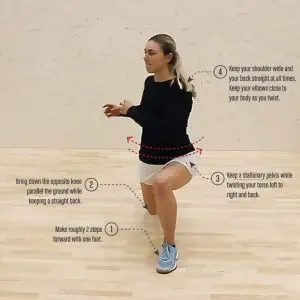
The first step in injury prevention is to warm up by doing some light cardio. Working your heart rate up from resting will keep your heart healthy, but it will also get more blood pumping through your muscles and warm them up. Once your muscles are warmed up, you can do a few stretches to loosen them up and hopefully prevent strains and tears from happening.
Rest Days
Squash is a fun game, and if you play competitively you want to get in as much work as you can, but there is such a thing as too much squash. Repetitive work with no rest can lead to several ailments, including arthritis, tendonitis, and general fatigue.
Giving your body a chance to rest gives your muscles time to repair themselves, which will ultimately make you a stronger player. Listen to your body and rest accordingly, as your conditioning improves you will probably need less rest, but even pros need rest days once in a while.
Don’t Play Hurt
There used to be this idea that playing hurt made you tough, but that idea has come around a full 180 degrees because now we know that playing hurt is absolutely the worst thing you can do. Taking a few days off to rest and ice an injury will prevent you from having to take an entire year off to rehab a major injury.
Squash Players, Programs & Records
A game with a history as illustrious as squash is bound to have some great figures past and present. To truly understand and respect a sport, you should know where it comes from and where it’s going. This section is full of general information about some of the greatest squash stars past and present and standing records.
Squash Greats
These players have made the game what it is and set the standard for today’s players.
Jahangir Khan
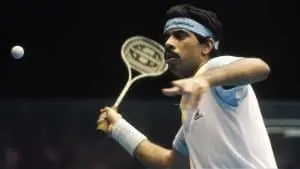
Khan has a great backstory; surprisingly, there hasn’t been a movie made about him. He was born in Pakistan and so weak as a child that his doctor advised against any physical activity. Despite his adversity, Khan went on to be one of the greatest squash players with a record 555 wins in a row and six world championship titles among others.
Nicol David
Height is an advantage in squash, but Nicol David proves that it is not necessary. This Malaysian rose to prominence in the early 2000s when she won two world junior titles, a feat that had never been accomplished before. From there she moved into the big leagues and won eight world championships. As of 2020, David is still playing, so there may be more championships to come.
Ramy Ashour
Ashour has had a career plagued with injuries, which is unfortunate because some believe that he could have been the greatest of all time. Despite his setbacks, he has still won three world championships and is the youngest world junior champion of all time.
Heather McKay
McKay only won a single world championship, but her body of work as a whole makes her one of the greatest players of all time. With sixteen British Open titles and only two professional losses to her name, stepping onto the court with McKay must have been an intimidating situation.
Amr Shabana
You don’t get a nickname like the Maestro without being in the running for greatest of all time. He won four world championships and an impressive thirty-three PSA world tour titles.
Susan Devoy
Susan Devoy’s career spanned a little over a decade when she shocked the squash world by retiring young. Though Devoy walked away from the sport, she left a lasting impression with a handful of world championships and had numerous records to her name.
Jansher Khan
Jansher had an illustrious career in the 80s and 90s where he won eight world championships. They are not related, but he and Jahangir might have well have been with the way they battled it out through those decades. Jansher was known for having almost superhuman reflexes.
Nour El Sherbini
Nour El Sherbini is still playing today, but she has already written herself into the history of the sport. She holds multiple records as the youngest player in multiple tournaments and has already won two world championships and seventeen PSA tour titles. With so many accomplishments under her belt so far, it is hard to believe there isn’t more to come.
Jonathon Power
Though he doesn’t have a lot of world championships under his racquet, Jonathon Power deserves a spot in the squash history books. He was the first North American to reach number one in the world rankings. He is highly regarded as one of the greatest shot makers in the history of the sport.
Raneem El Welily
El Welily has plenty to feel proud about with a world championship and 17 PSA tour titles to her name, but it is her style of play that makes her one of the greats. She is known for her unpredictable style and shot-making ability. With some gas left in the tank, El Welily still has time to scribble her name a few more places in the history books.
Top-Ranked Men’s Players
These are the top-ranked men’s players around the world as well as some important statistics.
# 1 – Ali Farag
- Years Playing: 10
- Record: 280-70
- Interesting Fact: Graduated from Harvard with a degree in mechanical engineering.
#2 – Mohamed Elshorbagy 
- Years Playing: 13
- Record: 400-120
- Interesting Fact: Became the first player in history to secure a maiden PSA World Tour title at a five-star event.
#3 – Tarek Momen 
- Years Playing: 14
- Record: 252-154
- Interesting Fact: Had to wait five years to collect winner’s prize money for a tournament once.
#4 – Karim Abdel Gawad 
- Years Playing: 11
- Record: 265-112
- Interesting Fact: He won the first PSA World Tour event that he participated in.
#5 – Simon Rösner 
- Years Playing: 15
- Record: 293-192
- Interesting Fact: When he’s not on the squash court, you can find him on the golf links.
Top-Ranked Women’s Players
These are the top-ranked women’s players around the world as well as some important statistics.
#1 – Raneem El Welily 
- Years Playing: 17
- Record: 340-145
- Interesting Fact: Won the World Junior Championship twice.
#2 – Nour El Sherbini 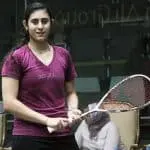
- Years Playing: 10
- Record: 226-69
- Interesting Fact: She is the youngest ever World Junior Champion
#3 – Camille Serme 
- Years Playing: 14
- Record: 264-135
- Interesting Fact: Has an interest in photography.
#4 – Nouran Gohar 
- Years Playing: 8
- Record: 216-73
- Interesting Fact: Spends her downtime reading and drawing.
#5 – Nour El Tayeb 
- Years Playing: 12
- Record: 189-97
- Interesting Fact: When she’s not dominating in tournaments she enjoys traveling.
Top-Ranked Men’s College Programs 
- Harvard (16-0)
- Trinity College (16-3)
- University of Pennsylvania (14-4)
- University of Rochester (14-4)
- Yale (12-6)
- Columbia University ( 9-7)
- Dartmouth (9-8)
- Princeton (7-9)
- George Washington University (13-12)
- Drexel University (13-12)
Top-Ranked Women’s College Programs 
- Harvard (13-0)
- Trinity College (17-3)
- Stanford (8-5)
- Princeton (14-3)
- Yale (12-5)
- Columbia University (8-8)
- Drexel University (8-8)
- University of Pennsylvania (10-7)
- Cornell (8-10)
- Dartmouth (7-8)
Squash Records
With a history as long as squash, there are plenty of records that have been set and broken. This section contains some of the more impressive feats in the sport.
- On September 4th and 5th of 2015, Len Granger and Jamie Barnett set the record for the longest squash marathon ever by playing for 38 hours and 27 seconds.
- On December 10th of 2017, Simon Boughton and Mark James set the record for the longest rally with an unbelievable 2,536 shots that lasted for 1 hour, 4 minutes, and 28 seconds.
- Shawn Delierre and Leo Au played the longest pro match in 2015. The match lasted 2 hours and 50 minutes.
- The record for the fastest squash ball ever hit belongs to pro-Cameron Pilley. He has hit the ball at an astonishing 177 mph.
- The longest win streak of squash or any sport for that matter belongs to Jahangir Khan. He has won 555 games in a row from 1981 to 1986.
- Geoff Hunt holds the record for the oldest squash world champion. He was 33 1/2 years old.
- Jahangir Khan lands in the record books again as the youngest player to win a world championship at 17.
- The record for the longest time ranked as number one belongs to Nicol David. He spent an impressive 108 consecutive months at the top of the world rankings.
Great resource. Many thanks. I think a lot of people underestimate the importance of a good grip and how much it can affect the play.